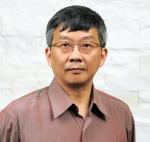Surface structures by direct transform of electron diffraction patterns
- Citation:
- Chang, C. Y., Hong I. H., Chou Y. C., & Wei C. M. (2001). Surface structures by direct transform of electron diffraction patterns. Journal of Physics-Condensed Matter. 13, 10709-10728., Nov, Number 47
Abstract:
We find that electron diffraction patterns can be directly inverted to provide three-dimensional atomic structures for the system studied. Depending on the scattering process, either holography or a Patterson inversion scheme is used. For diffraction patterns which were generated from a localized emitter source or predominantly by an inelastic-scattering feature like low-energy Kikuchi electrons, holography inversion is needed. The information obtained from Kikuchi electron holography includes the building blocks on the surface and their relative position to the atoms below the surface layer. On the other hand, for diffraction patterns generated predominantly by an inelastic-scattering feature like low-energy electron diffraction (LEED), a Patterson inversion is needed. The information obtained from the Patterson transform of the LEED I(E) curves is the relative positions of surface atoms to the atoms in underlying layers; no intra-layer information can be extracted with this method. High-fidelity and artifact-free three-dimensional atomic structures obtained by inversion of low-energy Kikuchi electron patterns and low-energy electron diffraction curves are presented. The results from the two inversion methods are complementary and can be used to construct or to discriminate the surface atomic structural models. The future of these direct methods by inverting diffraction patterns is discussed.
Notes:
ISI Document Delivery No.: 505YPTimes Cited: 0Cited Reference Count: 49Cited References: Abukawa T, 1999, PHYS REV LETT, V82, P335, DOI 10.1103/PhysRevLett.82.335 AHN H, 2001, OHYS REV LETT, V86, P2818 BARTON JJ, 1988, PHYS REV LETT, V61, P1356, DOI 10.1103/PhysRevLett.61.1356 BARTON JJ, 1991, PHYS REV LETT, V67, P3106, DOI 10.1103/PhysRevLett.67.3106 BAUER E, 1995, PHYS REV B, V51, P17891, DOI 10.1103/PhysRevB.51.17891 Chang CY, 1999, PHYS REV LETT, V83, P2580, DOI 10.1103/PhysRevLett.83.2580 Chang CY, 1999, PHYS REV B, V59, P10453, DOI 10.1103/PhysRevB.59.R10453 Chen X, 1996, SURF SCI, V356, P28, DOI 10.1016/0039-6028(96)00036-2 DABROWSKI J, 1994, PHYS REV LETT, V73, P1660 DING YG, 1991, PHYS REV LETT, V67, P1454, DOI 10.1103/PhysRevLett.67.1454 DING YG, 1992, SURF SCI, V275, pL691, DOI 10.1016/0039-6028(92)90785-5 Gai Z, 1996, PHYS REV B, V54, P8593, DOI 10.1103/PhysRevB.54.8593 HARP GR, 1990, PHYS REV LETT, V65, P1012, DOI 10.1103/PhysRevLett.65.1012 Hong IH, 1997, SURF REV LETT, V4, P733, DOI 10.1142/S0218625X97000730 Hong IH, 1996, PHYS REV B, V54, P4762, DOI 10.1103/PhysRevB.54.4762 HONG IH, 1994, SURF SCI, V312, pL743, DOI 10.1016/0039-6028(94)90794-3 HUANG H, 1994, SURF REV LETT, V1, P221, DOI 10.1142/S0218625X94000229 JOCOBI K, 1993, SURF SCI, V284, P223 KNALL J, 1991, PHYS REV LETT, V66, P1733, DOI 10.1103/PhysRevLett.66.1733 KRESSE G, 1993, PHYS REV B, V47, P558, DOI 10.1103/PhysRevB.47.558 KRESSE G, 1994, J PHYS-CONDENS MAT, V6, P8245, DOI 10.1088/0953-8984/6/40/015 KRESSE G, 1994, PHYS REV B, V49, P14251, DOI 10.1103/PhysRevB.49.14251 Laracuente A, 1998, PHYS REV LETT, V81, P5177, DOI 10.1103/PhysRevLett.81.5177 LIU AY, 1990, PHYS REV B, V41, P10727, DOI 10.1103/PhysRevB.41.10727 Luh DA, 1998, PHYS REV LETT, V81, P4160, DOI 10.1103/PhysRevLett.81.4160 MARTENSSON P, 1990, PHYS REV B, V42, P7230, DOI 10.1103/PhysRevB.42.7230 Morita Y, 1999, SURF SCI, V443, pL1037, DOI 10.1016/S0039-6028(99)01021-3 Nakatani S, 1996, SURF SCI, V357, P65, DOI 10.1016/0039-6028(96)00059-3 NISHIJIMA M, 1984, SURF SCI, V137, P473, DOI 10.1016/0039-6028(84)90524-7 NOGAMI J, 1994, SURF REV LETT, V1, P395, DOI 10.1142/S0218625X94000369 RANKE W, 1990, PHYS REV B, V41, P5243, DOI 10.1103/PhysRevB.41.5243 Rottger B, 1996, J VAC SCI TECHNOL B, V14, P1051 SALDIN DK, 1990, PHYS REV LETT, V64, P1270, DOI 10.1103/PhysRevLett.64.1270 Saldin DK, 1997, SURF REV LETT, V4, P991, DOI 10.1142/S0218625X97001176 Wang XS, 1999, PHYS REV B, V60, pR2146, DOI 10.1103/PhysRevB.60.R2146 SZOKE A, 1986, AIP C P, V147 TAKAHASHI T, 1988, JPN J APPL PHYS 2, V27, pL753, DOI 10.1143/JJAP.27.L753 TONG SY, 1991, PHYS REV LETT, V67, P3102, DOI 10.1103/PhysRevLett.67.3102 Van Hove M. A., 1986, LOW ENERGY ELECT DIF Vogler H, 1998, PHYS REV B, V57, P2315, DOI 10.1103/PhysRevB.57.2315 WANG J, 1996, PHYS REV B, V54, P13774 WATANABE S, 1991, PHYS REV B, V44, P8330, DOI 10.1103/PhysRevB.44.8330 WEI CM, 1992, SURF SCI, V274, pL577, DOI 10.1016/0039-6028(92)90828-T WEI CM, 1994, SURF REV LETT, V1, P335, DOI 10.1142/S0218625X94000333 WEI CM, UNPUB WEI CM, 1994, PHYS REV B, V49, P5109, DOI 10.1103/PhysRevB.49.5109 WEI CM, 1994, PHYS REV LETT, V72, P2434, DOI 10.1103/PhysRevLett.72.2434 XU YN, 1995, PHYS REV B, V51, P17379, DOI 10.1103/PhysRevB.51.17379 Zhao GL, 1998, PHYS REV B, V58, P1887, DOI 10.1103/PhysRevB.58.1887Chang, CY Hong, IH Chou, YC Wei, CMIOP PUBLISHING LTDBRISTOL

